Analyzing Motivation's Role in Boosting Employee Morale: Hilton Hotels
VerifiedAdded on 2023/01/13
|10
|2634
|31
Report
AI Summary
This report delves into the crucial role of motivation in enhancing employee morale within Hilton Hotels. It begins by establishing the background, aims, and objectives, followed by a rationale and the significance of the study. A comprehensive literature review explores various motivational theories and their practical applications. The research methodology outlines the qualitative approach, inductive approach, and interpretivism philosophy adopted for data collection. The report emphasizes the importance of motivation in increasing employee productivity and reducing turnover, highlighting challenges such as diverse employee needs and the dynamic business environment. It also examines several motivational theories, including Maslow's hierarchy of needs, Herzberg's two-factor theory, and Vroom's expectancy theory. The study will use primary and secondary data sources, including questionnaires, interviews, and existing literature, to generate findings and offer recommendations for fostering a motivated and committed work environment at Hilton Hotels. The report aims to provide insights for other scholars and organizations, offering critical findings and understanding the essential role of motivation in the workplace.
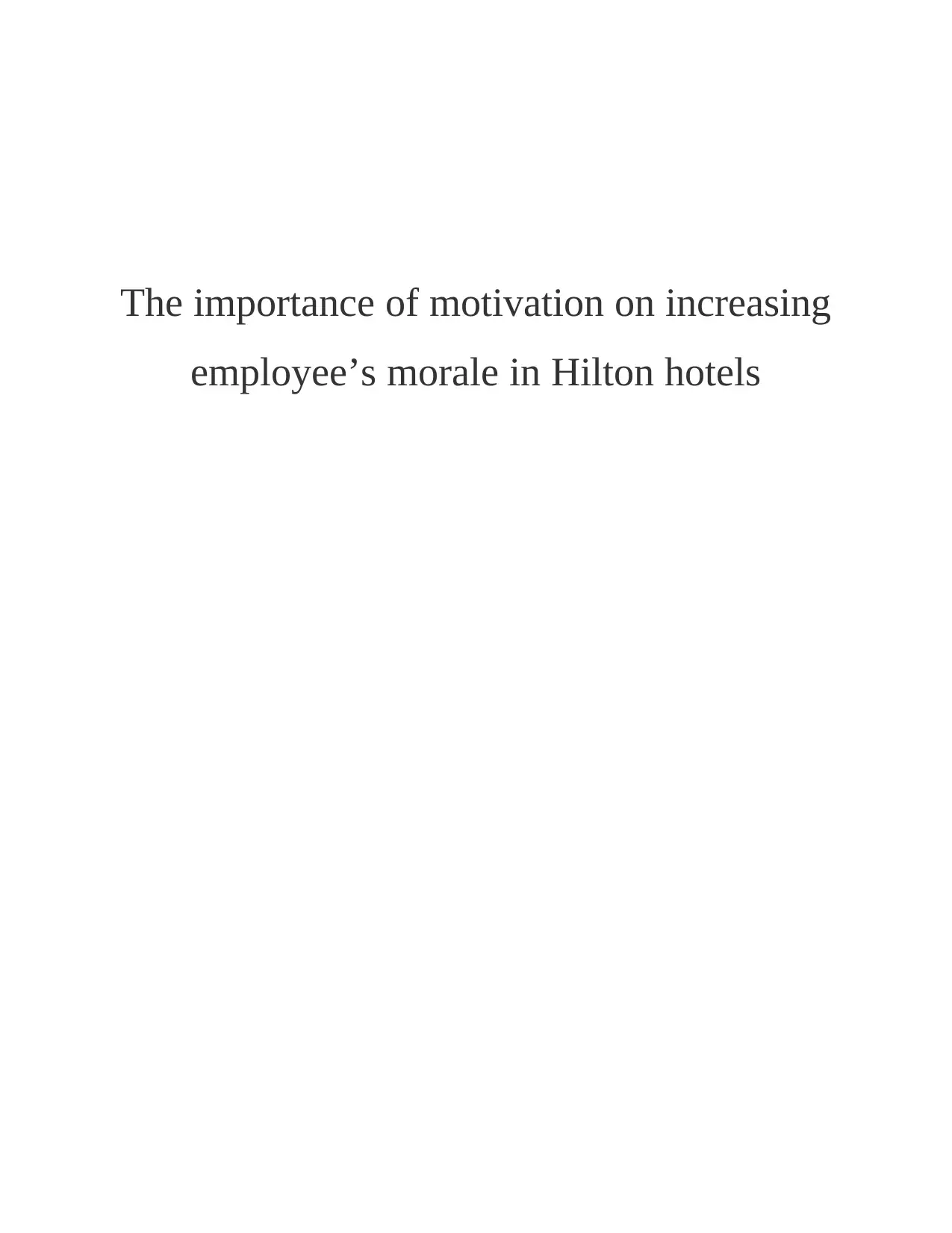
The importance of motivation on increasing
employee’s morale in Hilton hotels
employee’s morale in Hilton hotels
Paraphrase This Document
Need a fresh take? Get an instant paraphrase of this document with our AI Paraphraser
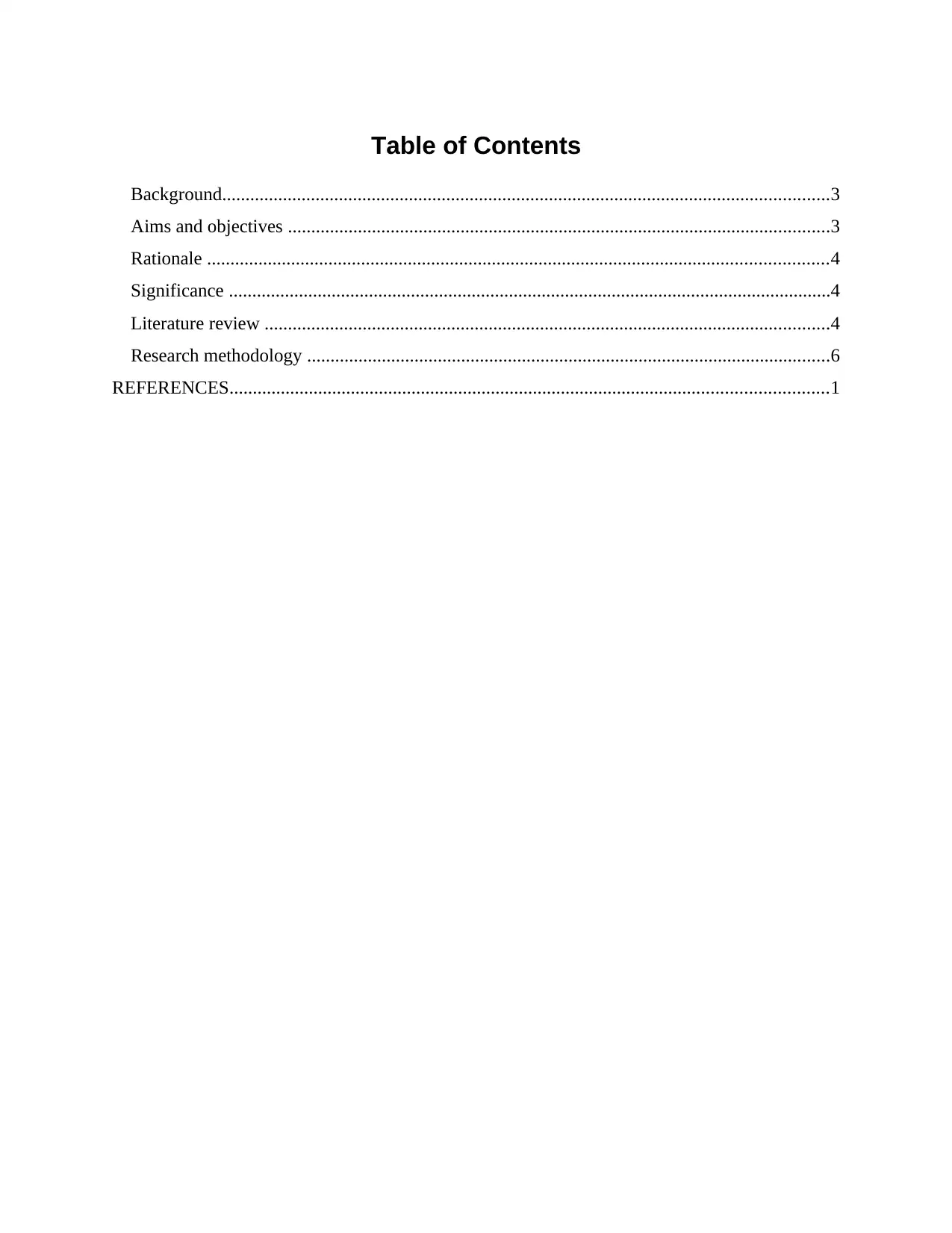
Table of Contents
Background..................................................................................................................................3
Aims and objectives ....................................................................................................................3
Rationale .....................................................................................................................................4
Significance .................................................................................................................................4
Literature review .........................................................................................................................4
Research methodology ................................................................................................................6
REFERENCES................................................................................................................................1
Background..................................................................................................................................3
Aims and objectives ....................................................................................................................3
Rationale .....................................................................................................................................4
Significance .................................................................................................................................4
Literature review .........................................................................................................................4
Research methodology ................................................................................................................6
REFERENCES................................................................................................................................1
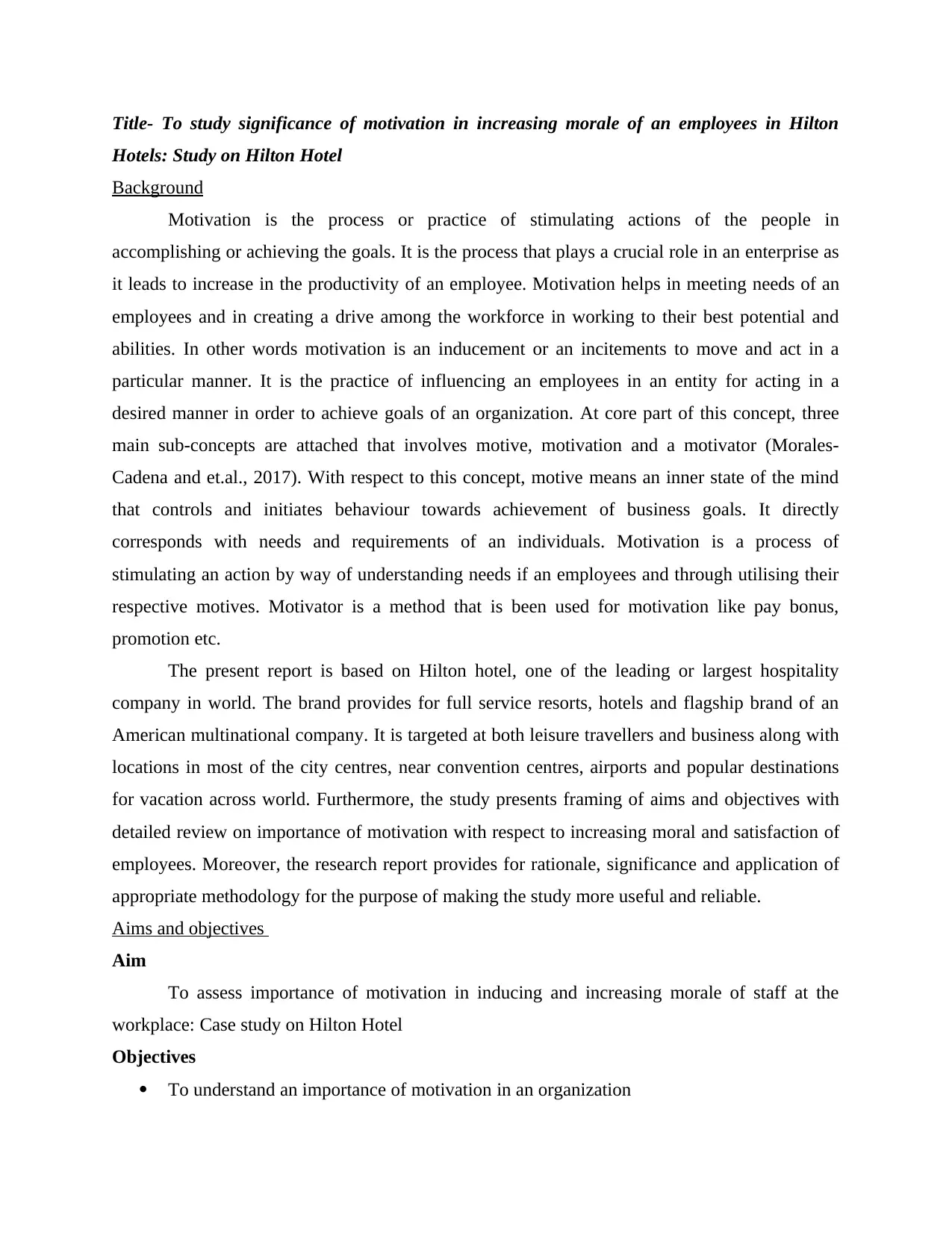
Title- To study significance of motivation in increasing morale of an employees in Hilton
Hotels: Study on Hilton Hotel
Background
Motivation is the process or practice of stimulating actions of the people in
accomplishing or achieving the goals. It is the process that plays a crucial role in an enterprise as
it leads to increase in the productivity of an employee. Motivation helps in meeting needs of an
employees and in creating a drive among the workforce in working to their best potential and
abilities. In other words motivation is an inducement or an incitements to move and act in a
particular manner. It is the practice of influencing an employees in an entity for acting in a
desired manner in order to achieve goals of an organization. At core part of this concept, three
main sub-concepts are attached that involves motive, motivation and a motivator (Morales-
Cadena and et.al., 2017). With respect to this concept, motive means an inner state of the mind
that controls and initiates behaviour towards achievement of business goals. It directly
corresponds with needs and requirements of an individuals. Motivation is a process of
stimulating an action by way of understanding needs if an employees and through utilising their
respective motives. Motivator is a method that is been used for motivation like pay bonus,
promotion etc.
The present report is based on Hilton hotel, one of the leading or largest hospitality
company in world. The brand provides for full service resorts, hotels and flagship brand of an
American multinational company. It is targeted at both leisure travellers and business along with
locations in most of the city centres, near convention centres, airports and popular destinations
for vacation across world. Furthermore, the study presents framing of aims and objectives with
detailed review on importance of motivation with respect to increasing moral and satisfaction of
employees. Moreover, the research report provides for rationale, significance and application of
appropriate methodology for the purpose of making the study more useful and reliable.
Aims and objectives
Aim
To assess importance of motivation in inducing and increasing morale of staff at the
workplace: Case study on Hilton Hotel
Objectives
To understand an importance of motivation in an organization
Hotels: Study on Hilton Hotel
Background
Motivation is the process or practice of stimulating actions of the people in
accomplishing or achieving the goals. It is the process that plays a crucial role in an enterprise as
it leads to increase in the productivity of an employee. Motivation helps in meeting needs of an
employees and in creating a drive among the workforce in working to their best potential and
abilities. In other words motivation is an inducement or an incitements to move and act in a
particular manner. It is the practice of influencing an employees in an entity for acting in a
desired manner in order to achieve goals of an organization. At core part of this concept, three
main sub-concepts are attached that involves motive, motivation and a motivator (Morales-
Cadena and et.al., 2017). With respect to this concept, motive means an inner state of the mind
that controls and initiates behaviour towards achievement of business goals. It directly
corresponds with needs and requirements of an individuals. Motivation is a process of
stimulating an action by way of understanding needs if an employees and through utilising their
respective motives. Motivator is a method that is been used for motivation like pay bonus,
promotion etc.
The present report is based on Hilton hotel, one of the leading or largest hospitality
company in world. The brand provides for full service resorts, hotels and flagship brand of an
American multinational company. It is targeted at both leisure travellers and business along with
locations in most of the city centres, near convention centres, airports and popular destinations
for vacation across world. Furthermore, the study presents framing of aims and objectives with
detailed review on importance of motivation with respect to increasing moral and satisfaction of
employees. Moreover, the research report provides for rationale, significance and application of
appropriate methodology for the purpose of making the study more useful and reliable.
Aims and objectives
Aim
To assess importance of motivation in inducing and increasing morale of staff at the
workplace: Case study on Hilton Hotel
Objectives
To understand an importance of motivation in an organization
⊘ This is a preview!⊘
Do you want full access?
Subscribe today to unlock all pages.

Trusted by 1+ million students worldwide
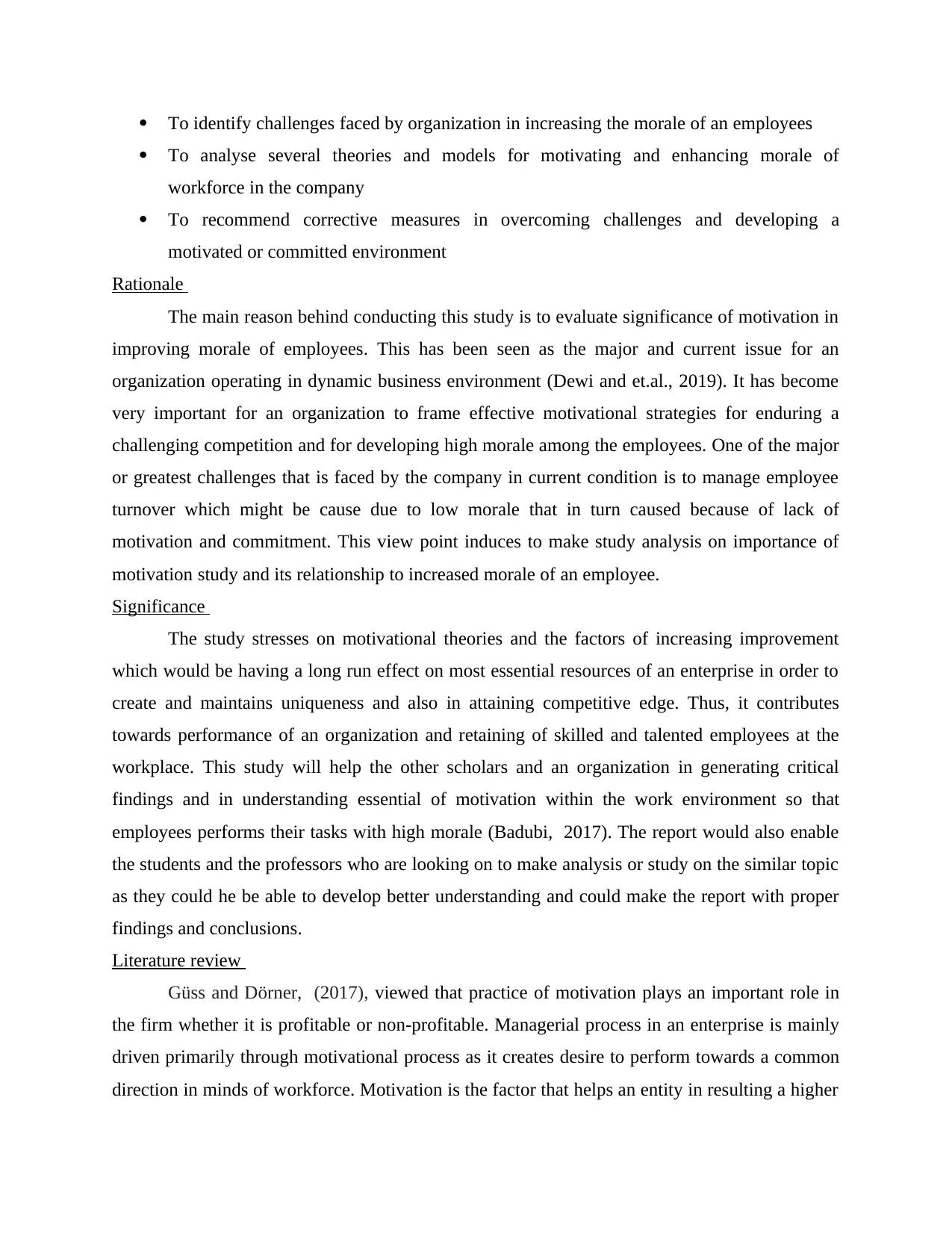
To identify challenges faced by organization in increasing the morale of an employees
To analyse several theories and models for motivating and enhancing morale of
workforce in the company
To recommend corrective measures in overcoming challenges and developing a
motivated or committed environment
Rationale
The main reason behind conducting this study is to evaluate significance of motivation in
improving morale of employees. This has been seen as the major and current issue for an
organization operating in dynamic business environment (Dewi and et.al., 2019). It has become
very important for an organization to frame effective motivational strategies for enduring a
challenging competition and for developing high morale among the employees. One of the major
or greatest challenges that is faced by the company in current condition is to manage employee
turnover which might be cause due to low morale that in turn caused because of lack of
motivation and commitment. This view point induces to make study analysis on importance of
motivation study and its relationship to increased morale of an employee.
Significance
The study stresses on motivational theories and the factors of increasing improvement
which would be having a long run effect on most essential resources of an enterprise in order to
create and maintains uniqueness and also in attaining competitive edge. Thus, it contributes
towards performance of an organization and retaining of skilled and talented employees at the
workplace. This study will help the other scholars and an organization in generating critical
findings and in understanding essential of motivation within the work environment so that
employees performs their tasks with high morale (Badubi, 2017). The report would also enable
the students and the professors who are looking on to make analysis or study on the similar topic
as they could he be able to develop better understanding and could make the report with proper
findings and conclusions.
Literature review
Güss and Dörner, (2017), viewed that practice of motivation plays an important role in
the firm whether it is profitable or non-profitable. Managerial process in an enterprise is mainly
driven primarily through motivational process as it creates desire to perform towards a common
direction in minds of workforce. Motivation is the factor that helps an entity in resulting a higher
To analyse several theories and models for motivating and enhancing morale of
workforce in the company
To recommend corrective measures in overcoming challenges and developing a
motivated or committed environment
Rationale
The main reason behind conducting this study is to evaluate significance of motivation in
improving morale of employees. This has been seen as the major and current issue for an
organization operating in dynamic business environment (Dewi and et.al., 2019). It has become
very important for an organization to frame effective motivational strategies for enduring a
challenging competition and for developing high morale among the employees. One of the major
or greatest challenges that is faced by the company in current condition is to manage employee
turnover which might be cause due to low morale that in turn caused because of lack of
motivation and commitment. This view point induces to make study analysis on importance of
motivation study and its relationship to increased morale of an employee.
Significance
The study stresses on motivational theories and the factors of increasing improvement
which would be having a long run effect on most essential resources of an enterprise in order to
create and maintains uniqueness and also in attaining competitive edge. Thus, it contributes
towards performance of an organization and retaining of skilled and talented employees at the
workplace. This study will help the other scholars and an organization in generating critical
findings and in understanding essential of motivation within the work environment so that
employees performs their tasks with high morale (Badubi, 2017). The report would also enable
the students and the professors who are looking on to make analysis or study on the similar topic
as they could he be able to develop better understanding and could make the report with proper
findings and conclusions.
Literature review
Güss and Dörner, (2017), viewed that practice of motivation plays an important role in
the firm whether it is profitable or non-profitable. Managerial process in an enterprise is mainly
driven primarily through motivational process as it creates desire to perform towards a common
direction in minds of workforce. Motivation is the factor that helps an entity in resulting a higher
Paraphrase This Document
Need a fresh take? Get an instant paraphrase of this document with our AI Paraphraser
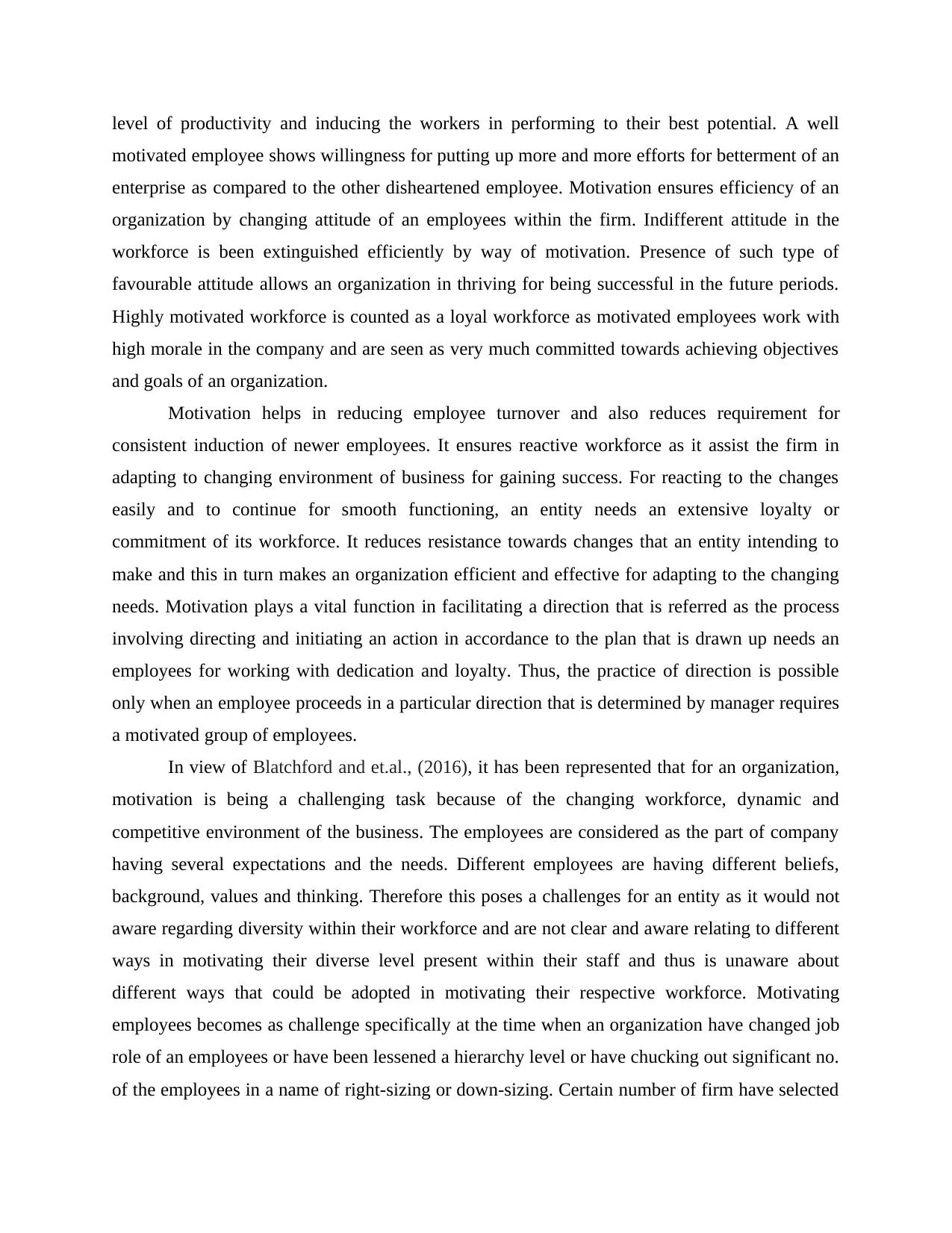
level of productivity and inducing the workers in performing to their best potential. A well
motivated employee shows willingness for putting up more and more efforts for betterment of an
enterprise as compared to the other disheartened employee. Motivation ensures efficiency of an
organization by changing attitude of an employees within the firm. Indifferent attitude in the
workforce is been extinguished efficiently by way of motivation. Presence of such type of
favourable attitude allows an organization in thriving for being successful in the future periods.
Highly motivated workforce is counted as a loyal workforce as motivated employees work with
high morale in the company and are seen as very much committed towards achieving objectives
and goals of an organization.
Motivation helps in reducing employee turnover and also reduces requirement for
consistent induction of newer employees. It ensures reactive workforce as it assist the firm in
adapting to changing environment of business for gaining success. For reacting to the changes
easily and to continue for smooth functioning, an entity needs an extensive loyalty or
commitment of its workforce. It reduces resistance towards changes that an entity intending to
make and this in turn makes an organization efficient and effective for adapting to the changing
needs. Motivation plays a vital function in facilitating a direction that is referred as the process
involving directing and initiating an action in accordance to the plan that is drawn up needs an
employees for working with dedication and loyalty. Thus, the practice of direction is possible
only when an employee proceeds in a particular direction that is determined by manager requires
a motivated group of employees.
In view of Blatchford and et.al., (2016), it has been represented that for an organization,
motivation is being a challenging task because of the changing workforce, dynamic and
competitive environment of the business. The employees are considered as the part of company
having several expectations and the needs. Different employees are having different beliefs,
background, values and thinking. Therefore this poses a challenges for an entity as it would not
aware regarding diversity within their workforce and are not clear and aware relating to different
ways in motivating their diverse level present within their staff and thus is unaware about
different ways that could be adopted in motivating their respective workforce. Motivating
employees becomes as challenge specifically at the time when an organization have changed job
role of an employees or have been lessened a hierarchy level or have chucking out significant no.
of the employees in a name of right-sizing or down-sizing. Certain number of firm have selected
motivated employee shows willingness for putting up more and more efforts for betterment of an
enterprise as compared to the other disheartened employee. Motivation ensures efficiency of an
organization by changing attitude of an employees within the firm. Indifferent attitude in the
workforce is been extinguished efficiently by way of motivation. Presence of such type of
favourable attitude allows an organization in thriving for being successful in the future periods.
Highly motivated workforce is counted as a loyal workforce as motivated employees work with
high morale in the company and are seen as very much committed towards achieving objectives
and goals of an organization.
Motivation helps in reducing employee turnover and also reduces requirement for
consistent induction of newer employees. It ensures reactive workforce as it assist the firm in
adapting to changing environment of business for gaining success. For reacting to the changes
easily and to continue for smooth functioning, an entity needs an extensive loyalty or
commitment of its workforce. It reduces resistance towards changes that an entity intending to
make and this in turn makes an organization efficient and effective for adapting to the changing
needs. Motivation plays a vital function in facilitating a direction that is referred as the process
involving directing and initiating an action in accordance to the plan that is drawn up needs an
employees for working with dedication and loyalty. Thus, the practice of direction is possible
only when an employee proceeds in a particular direction that is determined by manager requires
a motivated group of employees.
In view of Blatchford and et.al., (2016), it has been represented that for an organization,
motivation is being a challenging task because of the changing workforce, dynamic and
competitive environment of the business. The employees are considered as the part of company
having several expectations and the needs. Different employees are having different beliefs,
background, values and thinking. Therefore this poses a challenges for an entity as it would not
aware regarding diversity within their workforce and are not clear and aware relating to different
ways in motivating their diverse level present within their staff and thus is unaware about
different ways that could be adopted in motivating their respective workforce. Motivating
employees becomes as challenge specifically at the time when an organization have changed job
role of an employees or have been lessened a hierarchy level or have chucking out significant no.
of the employees in a name of right-sizing or down-sizing. Certain number of firm have selected
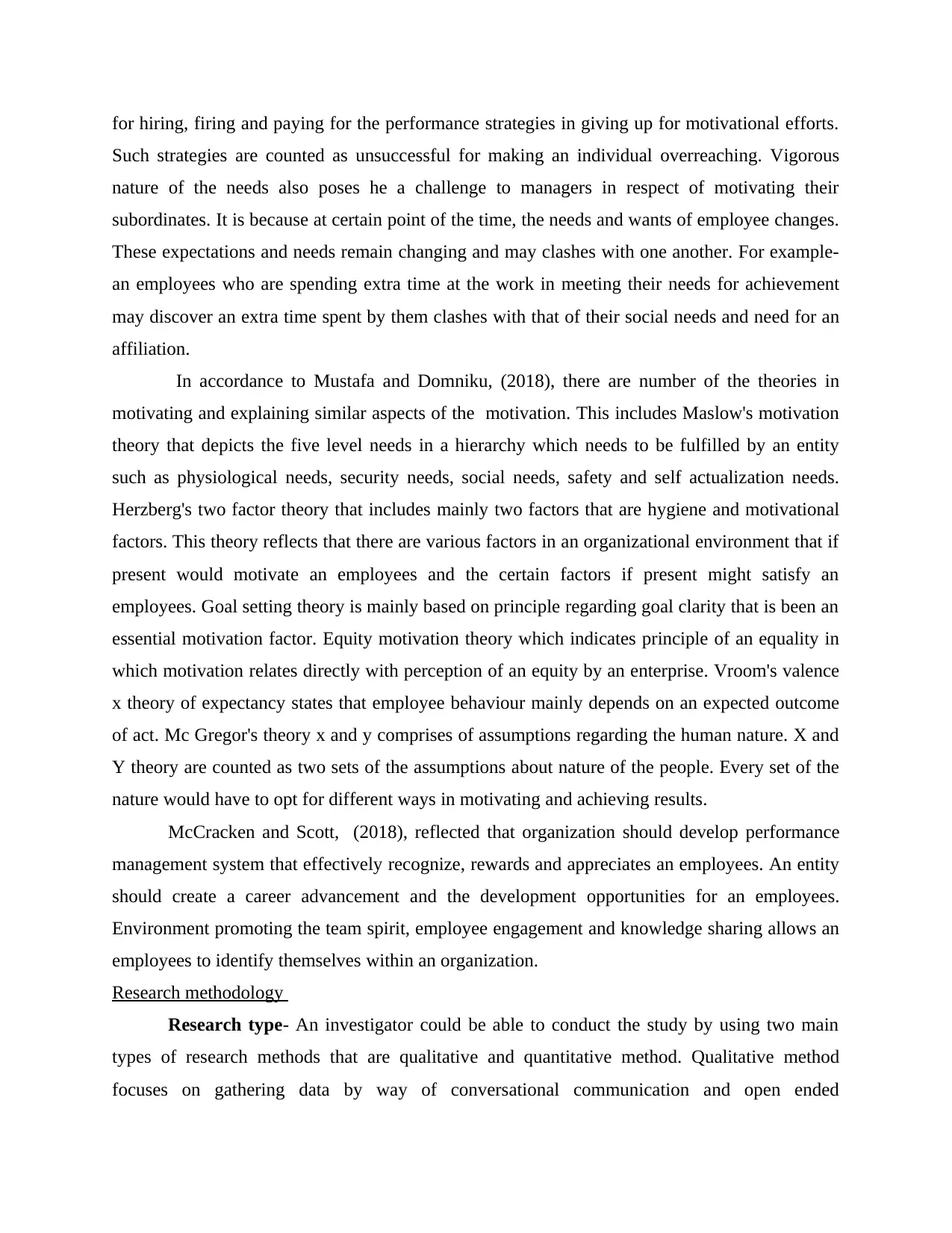
for hiring, firing and paying for the performance strategies in giving up for motivational efforts.
Such strategies are counted as unsuccessful for making an individual overreaching. Vigorous
nature of the needs also poses he a challenge to managers in respect of motivating their
subordinates. It is because at certain point of the time, the needs and wants of employee changes.
These expectations and needs remain changing and may clashes with one another. For example-
an employees who are spending extra time at the work in meeting their needs for achievement
may discover an extra time spent by them clashes with that of their social needs and need for an
affiliation.
In accordance to Mustafa and Domniku, (2018), there are number of the theories in
motivating and explaining similar aspects of the motivation. This includes Maslow's motivation
theory that depicts the five level needs in a hierarchy which needs to be fulfilled by an entity
such as physiological needs, security needs, social needs, safety and self actualization needs.
Herzberg's two factor theory that includes mainly two factors that are hygiene and motivational
factors. This theory reflects that there are various factors in an organizational environment that if
present would motivate an employees and the certain factors if present might satisfy an
employees. Goal setting theory is mainly based on principle regarding goal clarity that is been an
essential motivation factor. Equity motivation theory which indicates principle of an equality in
which motivation relates directly with perception of an equity by an enterprise. Vroom's valence
x theory of expectancy states that employee behaviour mainly depends on an expected outcome
of act. Mc Gregor's theory x and y comprises of assumptions regarding the human nature. X and
Y theory are counted as two sets of the assumptions about nature of the people. Every set of the
nature would have to opt for different ways in motivating and achieving results.
McCracken and Scott, (2018), reflected that organization should develop performance
management system that effectively recognize, rewards and appreciates an employees. An entity
should create a career advancement and the development opportunities for an employees.
Environment promoting the team spirit, employee engagement and knowledge sharing allows an
employees to identify themselves within an organization.
Research methodology
Research type- An investigator could be able to conduct the study by using two main
types of research methods that are qualitative and quantitative method. Qualitative method
focuses on gathering data by way of conversational communication and open ended
Such strategies are counted as unsuccessful for making an individual overreaching. Vigorous
nature of the needs also poses he a challenge to managers in respect of motivating their
subordinates. It is because at certain point of the time, the needs and wants of employee changes.
These expectations and needs remain changing and may clashes with one another. For example-
an employees who are spending extra time at the work in meeting their needs for achievement
may discover an extra time spent by them clashes with that of their social needs and need for an
affiliation.
In accordance to Mustafa and Domniku, (2018), there are number of the theories in
motivating and explaining similar aspects of the motivation. This includes Maslow's motivation
theory that depicts the five level needs in a hierarchy which needs to be fulfilled by an entity
such as physiological needs, security needs, social needs, safety and self actualization needs.
Herzberg's two factor theory that includes mainly two factors that are hygiene and motivational
factors. This theory reflects that there are various factors in an organizational environment that if
present would motivate an employees and the certain factors if present might satisfy an
employees. Goal setting theory is mainly based on principle regarding goal clarity that is been an
essential motivation factor. Equity motivation theory which indicates principle of an equality in
which motivation relates directly with perception of an equity by an enterprise. Vroom's valence
x theory of expectancy states that employee behaviour mainly depends on an expected outcome
of act. Mc Gregor's theory x and y comprises of assumptions regarding the human nature. X and
Y theory are counted as two sets of the assumptions about nature of the people. Every set of the
nature would have to opt for different ways in motivating and achieving results.
McCracken and Scott, (2018), reflected that organization should develop performance
management system that effectively recognize, rewards and appreciates an employees. An entity
should create a career advancement and the development opportunities for an employees.
Environment promoting the team spirit, employee engagement and knowledge sharing allows an
employees to identify themselves within an organization.
Research methodology
Research type- An investigator could be able to conduct the study by using two main
types of research methods that are qualitative and quantitative method. Qualitative method
focuses on gathering data by way of conversational communication and open ended
⊘ This is a preview!⊘
Do you want full access?
Subscribe today to unlock all pages.

Trusted by 1+ million students worldwide
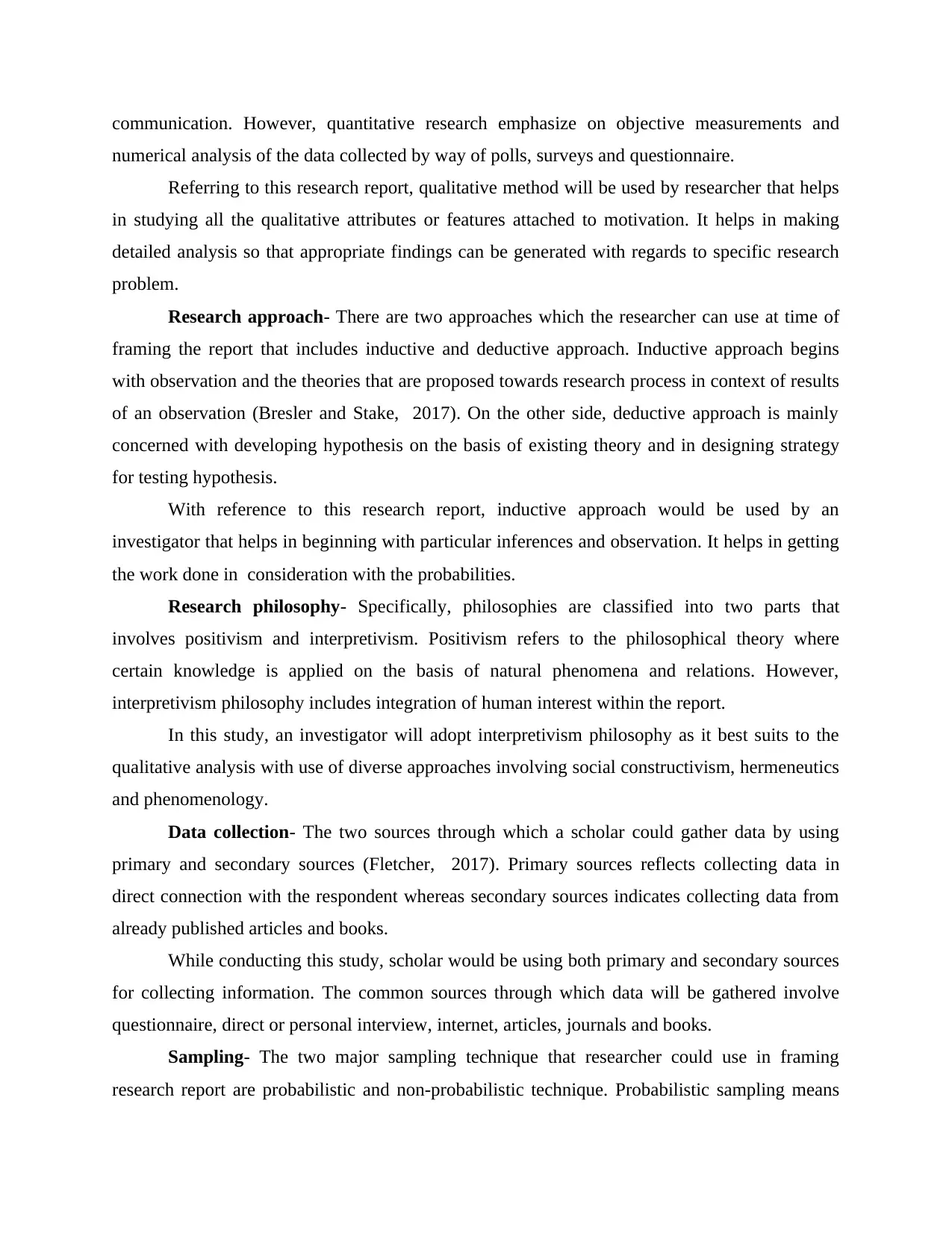
communication. However, quantitative research emphasize on objective measurements and
numerical analysis of the data collected by way of polls, surveys and questionnaire.
Referring to this research report, qualitative method will be used by researcher that helps
in studying all the qualitative attributes or features attached to motivation. It helps in making
detailed analysis so that appropriate findings can be generated with regards to specific research
problem.
Research approach- There are two approaches which the researcher can use at time of
framing the report that includes inductive and deductive approach. Inductive approach begins
with observation and the theories that are proposed towards research process in context of results
of an observation (Bresler and Stake, 2017). On the other side, deductive approach is mainly
concerned with developing hypothesis on the basis of existing theory and in designing strategy
for testing hypothesis.
With reference to this research report, inductive approach would be used by an
investigator that helps in beginning with particular inferences and observation. It helps in getting
the work done in consideration with the probabilities.
Research philosophy- Specifically, philosophies are classified into two parts that
involves positivism and interpretivism. Positivism refers to the philosophical theory where
certain knowledge is applied on the basis of natural phenomena and relations. However,
interpretivism philosophy includes integration of human interest within the report.
In this study, an investigator will adopt interpretivism philosophy as it best suits to the
qualitative analysis with use of diverse approaches involving social constructivism, hermeneutics
and phenomenology.
Data collection- The two sources through which a scholar could gather data by using
primary and secondary sources (Fletcher, 2017). Primary sources reflects collecting data in
direct connection with the respondent whereas secondary sources indicates collecting data from
already published articles and books.
While conducting this study, scholar would be using both primary and secondary sources
for collecting information. The common sources through which data will be gathered involve
questionnaire, direct or personal interview, internet, articles, journals and books.
Sampling- The two major sampling technique that researcher could use in framing
research report are probabilistic and non-probabilistic technique. Probabilistic sampling means
numerical analysis of the data collected by way of polls, surveys and questionnaire.
Referring to this research report, qualitative method will be used by researcher that helps
in studying all the qualitative attributes or features attached to motivation. It helps in making
detailed analysis so that appropriate findings can be generated with regards to specific research
problem.
Research approach- There are two approaches which the researcher can use at time of
framing the report that includes inductive and deductive approach. Inductive approach begins
with observation and the theories that are proposed towards research process in context of results
of an observation (Bresler and Stake, 2017). On the other side, deductive approach is mainly
concerned with developing hypothesis on the basis of existing theory and in designing strategy
for testing hypothesis.
With reference to this research report, inductive approach would be used by an
investigator that helps in beginning with particular inferences and observation. It helps in getting
the work done in consideration with the probabilities.
Research philosophy- Specifically, philosophies are classified into two parts that
involves positivism and interpretivism. Positivism refers to the philosophical theory where
certain knowledge is applied on the basis of natural phenomena and relations. However,
interpretivism philosophy includes integration of human interest within the report.
In this study, an investigator will adopt interpretivism philosophy as it best suits to the
qualitative analysis with use of diverse approaches involving social constructivism, hermeneutics
and phenomenology.
Data collection- The two sources through which a scholar could gather data by using
primary and secondary sources (Fletcher, 2017). Primary sources reflects collecting data in
direct connection with the respondent whereas secondary sources indicates collecting data from
already published articles and books.
While conducting this study, scholar would be using both primary and secondary sources
for collecting information. The common sources through which data will be gathered involve
questionnaire, direct or personal interview, internet, articles, journals and books.
Sampling- The two major sampling technique that researcher could use in framing
research report are probabilistic and non-probabilistic technique. Probabilistic sampling means
Paraphrase This Document
Need a fresh take? Get an instant paraphrase of this document with our AI Paraphraser
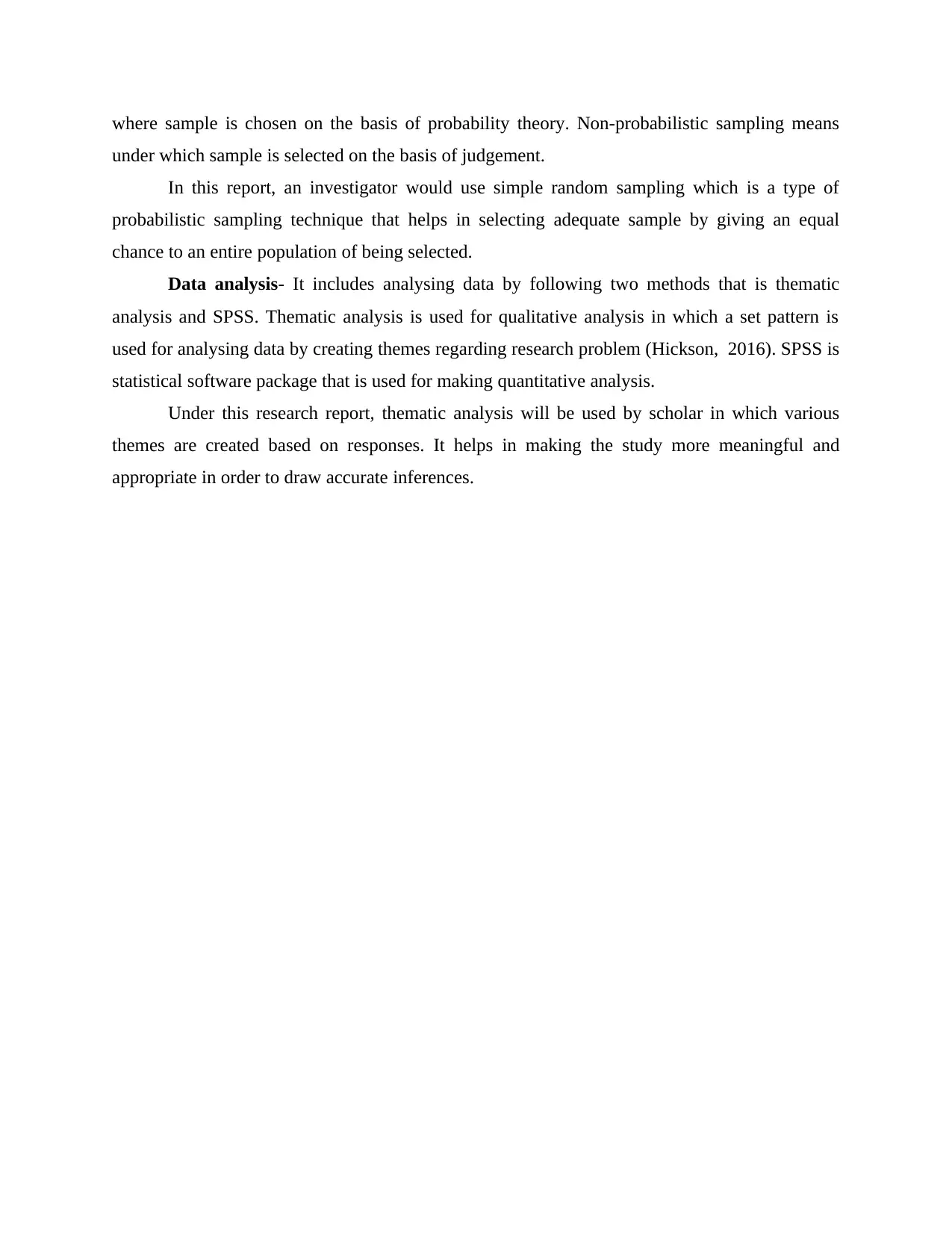
where sample is chosen on the basis of probability theory. Non-probabilistic sampling means
under which sample is selected on the basis of judgement.
In this report, an investigator would use simple random sampling which is a type of
probabilistic sampling technique that helps in selecting adequate sample by giving an equal
chance to an entire population of being selected.
Data analysis- It includes analysing data by following two methods that is thematic
analysis and SPSS. Thematic analysis is used for qualitative analysis in which a set pattern is
used for analysing data by creating themes regarding research problem (Hickson, 2016). SPSS is
statistical software package that is used for making quantitative analysis.
Under this research report, thematic analysis will be used by scholar in which various
themes are created based on responses. It helps in making the study more meaningful and
appropriate in order to draw accurate inferences.
under which sample is selected on the basis of judgement.
In this report, an investigator would use simple random sampling which is a type of
probabilistic sampling technique that helps in selecting adequate sample by giving an equal
chance to an entire population of being selected.
Data analysis- It includes analysing data by following two methods that is thematic
analysis and SPSS. Thematic analysis is used for qualitative analysis in which a set pattern is
used for analysing data by creating themes regarding research problem (Hickson, 2016). SPSS is
statistical software package that is used for making quantitative analysis.
Under this research report, thematic analysis will be used by scholar in which various
themes are created based on responses. It helps in making the study more meaningful and
appropriate in order to draw accurate inferences.
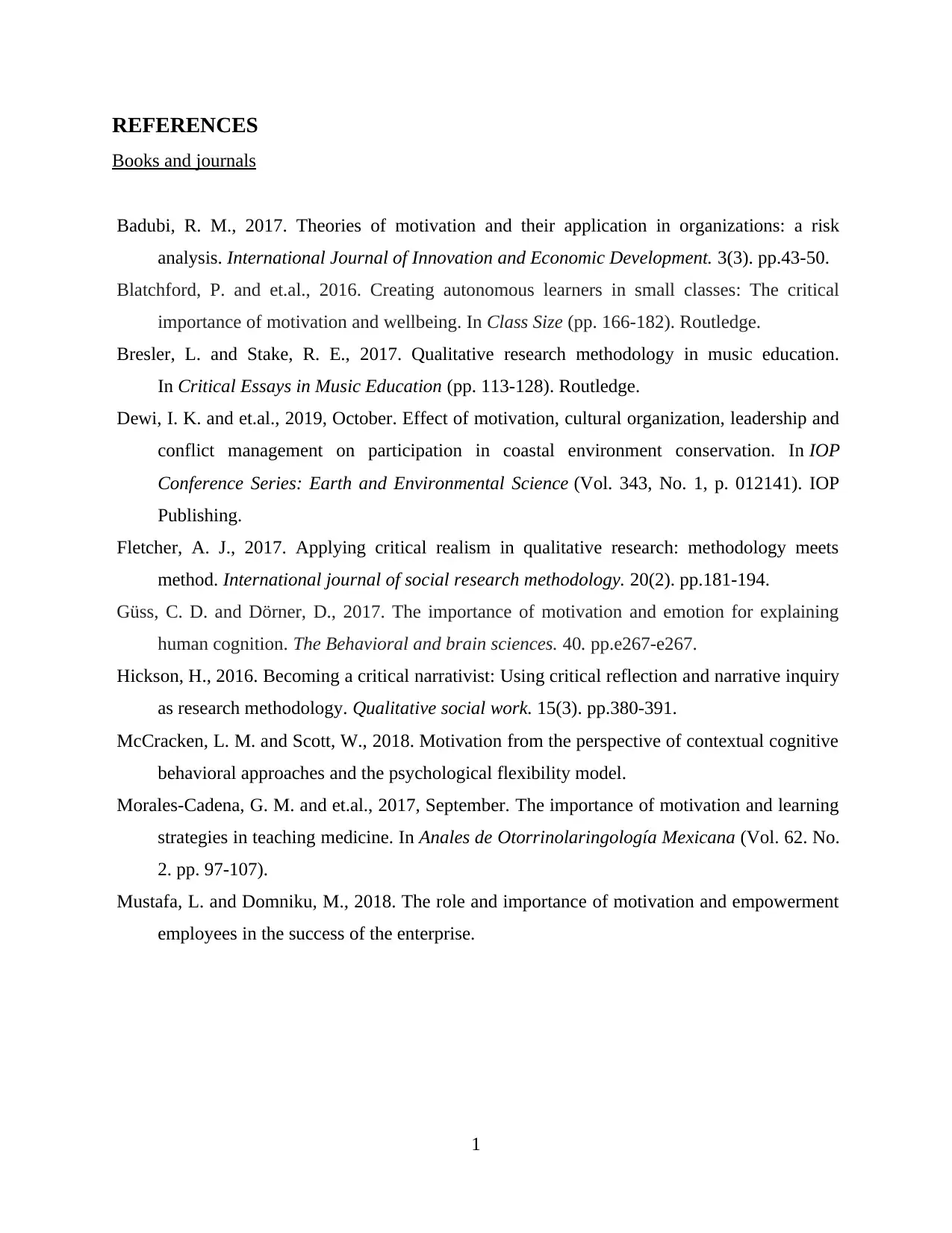
REFERENCES
Books and journals
Badubi, R. M., 2017. Theories of motivation and their application in organizations: a risk
analysis. International Journal of Innovation and Economic Development. 3(3). pp.43-50.
Blatchford, P. and et.al., 2016. Creating autonomous learners in small classes: The critical
importance of motivation and wellbeing. In Class Size (pp. 166-182). Routledge.
Bresler, L. and Stake, R. E., 2017. Qualitative research methodology in music education.
In Critical Essays in Music Education (pp. 113-128). Routledge.
Dewi, I. K. and et.al., 2019, October. Effect of motivation, cultural organization, leadership and
conflict management on participation in coastal environment conservation. In IOP
Conference Series: Earth and Environmental Science (Vol. 343, No. 1, p. 012141). IOP
Publishing.
Fletcher, A. J., 2017. Applying critical realism in qualitative research: methodology meets
method. International journal of social research methodology. 20(2). pp.181-194.
Güss, C. D. and Dörner, D., 2017. The importance of motivation and emotion for explaining
human cognition. The Behavioral and brain sciences. 40. pp.e267-e267.
Hickson, H., 2016. Becoming a critical narrativist: Using critical reflection and narrative inquiry
as research methodology. Qualitative social work. 15(3). pp.380-391.
McCracken, L. M. and Scott, W., 2018. Motivation from the perspective of contextual cognitive
behavioral approaches and the psychological flexibility model.
Morales-Cadena, G. M. and et.al., 2017, September. The importance of motivation and learning
strategies in teaching medicine. In Anales de Otorrinolaringología Mexicana (Vol. 62. No.
2. pp. 97-107).
Mustafa, L. and Domniku, M., 2018. The role and importance of motivation and empowerment
employees in the success of the enterprise.
1
Books and journals
Badubi, R. M., 2017. Theories of motivation and their application in organizations: a risk
analysis. International Journal of Innovation and Economic Development. 3(3). pp.43-50.
Blatchford, P. and et.al., 2016. Creating autonomous learners in small classes: The critical
importance of motivation and wellbeing. In Class Size (pp. 166-182). Routledge.
Bresler, L. and Stake, R. E., 2017. Qualitative research methodology in music education.
In Critical Essays in Music Education (pp. 113-128). Routledge.
Dewi, I. K. and et.al., 2019, October. Effect of motivation, cultural organization, leadership and
conflict management on participation in coastal environment conservation. In IOP
Conference Series: Earth and Environmental Science (Vol. 343, No. 1, p. 012141). IOP
Publishing.
Fletcher, A. J., 2017. Applying critical realism in qualitative research: methodology meets
method. International journal of social research methodology. 20(2). pp.181-194.
Güss, C. D. and Dörner, D., 2017. The importance of motivation and emotion for explaining
human cognition. The Behavioral and brain sciences. 40. pp.e267-e267.
Hickson, H., 2016. Becoming a critical narrativist: Using critical reflection and narrative inquiry
as research methodology. Qualitative social work. 15(3). pp.380-391.
McCracken, L. M. and Scott, W., 2018. Motivation from the perspective of contextual cognitive
behavioral approaches and the psychological flexibility model.
Morales-Cadena, G. M. and et.al., 2017, September. The importance of motivation and learning
strategies in teaching medicine. In Anales de Otorrinolaringología Mexicana (Vol. 62. No.
2. pp. 97-107).
Mustafa, L. and Domniku, M., 2018. The role and importance of motivation and empowerment
employees in the success of the enterprise.
1
⊘ This is a preview!⊘
Do you want full access?
Subscribe today to unlock all pages.

Trusted by 1+ million students worldwide

2
1 out of 10
Related Documents
Your All-in-One AI-Powered Toolkit for Academic Success.
+13062052269
info@desklib.com
Available 24*7 on WhatsApp / Email
![[object Object]](/_next/static/media/star-bottom.7253800d.svg)
Unlock your academic potential
Copyright © 2020–2025 A2Z Services. All Rights Reserved. Developed and managed by ZUCOL.





